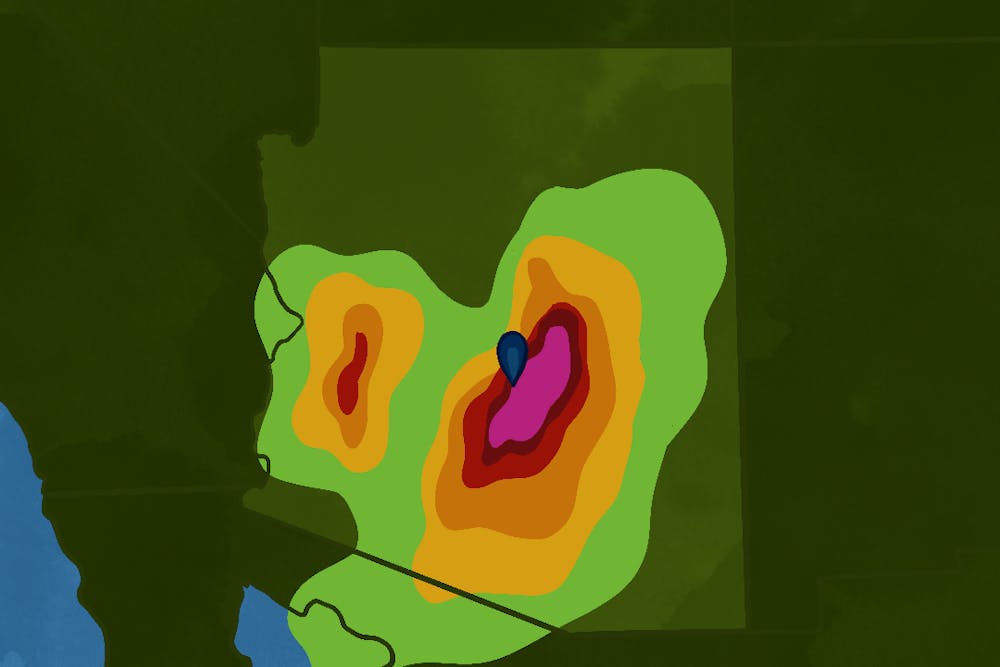Monsoon season arrived at ASU on Aug. 22, drenching students across campus and shutting off power in parts of Tempe. For out-of-state students, the sight of a torrential downpour in a typically dry state can be surprising.
The term monsoon refers not to a single storm, but a season of extreme weather events. Weather phenomena typical of a monsoon season includes thunderstorms, heavy rain, hail, flash floods, dust storms and high winds, according to ARIZONA ADOT.
“One time there was a monsoon going on and our recycling bin, that was outside, actually got blown into our garage,” said Joe Paing, a freshman who has yet to declare a major. “It broke our garage door.”
Storms sweep across Arizona from June to September, providing much needed rain in the desert and can cause damage to local infrastructure. Luckily, there are strategies every student can take to make it through the season.
Check local weather apps
One of the best ways to stay safe during monsoon season is to be aware of when a storm is going to hit. The National Weather Service has an office in Phoenix that monitors monsoon activity throughout the Phoenix Metro area.
The weather tracker provides a five day forecast and safety information while storms are happening. People can also find storm updates on social media and local news broadcasts.
"We have a really active Twitter (and) X arena where you can pay attention to the folks that I work with and hear what they have to say," said Erinanne Saffell, director of the Arizona State Climate Office and an associate professor of urban climate research.
Students can find updates from weather experts in Arizona using #azwx on social media. Professionals also post pictures and videos of storms from across the state.
"We have storm chasers in Arizona that take beautiful imagery," Saffell said. "There's a lot of activity you can pay attention to on social media."
Get inside
During a monsoon thunderstorm, high winds, rain and flooding often cause trees and other debris to fall.
According to the National Weather Service, Arizona receives approximately 50% of its annual rainfall and experienced over 200,000 lighting strikes during the monsoon season in 2023.
"The best place to be when we have our thunderstorms is a real building," Saffell said. "We've never heard of anyone in Arizona who's been hurt inside their house during a thunderstorm."
According to Saffell, an individual thunderstorm, or cell, typically lasts around an hour. However, most storms during monsoon season are made up of multiple cells and last for multiple hours.
While any type of cover is helpful during a thunderstorm, cars with steel tops and buildings are the safest place to be.
"Bring an umbrella and stay inside," said Hannah Friedman, a sophomore studying nursing. "Get out of the pool if you’re in there."
Pull over
The dust storms that occasionally precede thunderstorms make driving hazardous. The swirling dust reduces driver ability to see the road or cars in front of them.
"When we have really strong dust storms, or the visibility is dropped on the road, we want you to pull off the road. Take your foot off the brake and turn your lights off so people don't follow you and crash into you," Saffell said.
Driving through heavy rain is dangerous, especially on freeways where flooding increases the risk of hydroplaning. Hydroplaning occurs when the tires of the car lose traction with the pavement while driving over water.
Be prepared
Given the frequency of thunderstorms during monsoon season, it's important to always be prepared for the next one.
According to the City of Tempe, a small emergency kit should include water, non-perishable food, a flashlight, medication, batteries, phone chargers, a first aid kit and a radio.
"It's important to understand what's going on, how things operate, and pay attention all the time because it's exciting, but it possibly can be a dangerous time," Saffell said.
Edited by Senna James, Sophia Ramirez and Madeline Schmitke.
Reach the reporter at allipper@asu.edu and follow @lippert_audrey on X.
Like The State Press on Facebook and follow @statepress on X
Audrey is a sophomore studying journalism and mass communication with a minor in Spanish. This is her first semester with The State Press. She has also worked at Blaze Radio.




